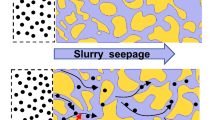Abstract
The pollution propagation within the underground water reservoirs is a challenging and important phenomenon. In the current work, the numerical simulation of pollution transport in an underground channel is performed using the meshless method. To account the anomalous dispersion in a general case, the variable order fractional mass transfer equation is utilized for a rectangular channel. The clean fluid stream enters the channel and due to several phenomenon including the leakage of pollution from the channel walls, the internal pollution source, and the occurrence of the chemical reactions, the pollution content is affected. The non-dimensional form of the governing equation is derived to introduce the dominant dimensionless group numbers. The numerical solution of the obtained equation is established based on the meshless local Petrov–Galerkin method using the moving Kriging interpolation. The Dirac delta function is used as a test function over the local sub-domains. To discretize the present formulation in space variables, we apply the moving Kriging shape functions. Also, to estimate the fractional-order versus the time, finite difference relation is utilized. Using Kronecker’s delta property of moving Kriging interpolation shape functions the boundary conditions in the final system are imposed automatically. The main aim of this technique is to investigate a global estimation for the model, which consequently decrease such problems to those of solving a system of algebraic equations. To determine the accuracy and efficiency of the present method on regular and irregular domains, an example is given in various domains and with regular and irregular distributed points. Also, the effect of major parameters including the fractional order exponent, leakage velocity, chemical reaction rate constant, diffusion coefficient in addition to the stationary/moving pollution source is also examined. It will be shown that, by enhancement of the diffusivity from 0.1 to 20, the outlet concentration reduces by 25.1%, while diffusivity increase from 20 to 50 affects the exiting pollution by merely 7.0%.












Similar content being viewed by others
References
Igor P (1999) Fractional differential equations, vol. 198 of mathematics in science and engineering
Hosseininia M, Heydari MH, Roohi R, Avazzadeh Z (2019) A computational wavelet method for variable-order fractional model of dual phase lag bioheat equation. J Computat Phys
Asma AE, Adem K, Bachok MT (2012) Application of homotopy perturbation and variational iteration methods for fredholm integro differential equation of fractional order. In: Abstract and Applied Analysis, volume 2012. Hindawi
Hossain J, Abdelouhab K, Dumitru B, Tuğba Y (2012) Solutions of the fractional davey-stewartson equations with variational iteration method
Rui D, Cao WR, Sun ZZ (2010) A compact difference scheme for the fractional diffusion-wave equation. Appl Math Model 34(10):2998–3007
Weiping B, Tang Y, Yingchuan W, Yang J (2015) Finite difference/finite element method for two-dimensional space and time fractional Bloch-Torrey equations. J Computat Phys 293:264–279
Heydari MH, Hooshmandasl MR, Maalek Ghaini FM (2014) An efficient computational method for solving fractional biharmonic equation. Comput Math Appl 68(3):269–287
Heydari MH, Hooshmandasl MR, Maalek Ghaini FM, Cattani C (2016) Wavelets method for solving fractional optimal control problems. Appl Math Comput 286:139–154
Heydari MH, Hooshmandasl MR, Mohammadi F, Cattani C (2014) Wavelets method for solving systems of nonlinear singular fractional volterra integro-differential equations. Commun Nonlinear Sci Numer Simul 19(1):37–48
dos Santos MAF (2019) Analytic approaches of the anomalous diffusion: a review. Chaos Sol Fract 124:86–96
Zhang X, Liu L, Wu Y, Wiwatanapataphee B (2017) Nontrivial solutions for a fractional advection dispersion equation in anomalous diffusion. Appl Math Lett 66:1–8
Yang XJ, Tenreiro JA, Machado, (2017) A new fractional operator of variable order: application in the description of anomalous diffusion. Physica A Stat Mech Appl 481:276–283
Roohi R, Heydari MH, Sun HG (2019) Numerical study of unsteady natural convection of variable-order fractional jeffrey nanofluid over an oscillating plate in a porous medium involved with magnetic, chemical and heat absorption effects using chebyshev cardinal functions. Eur Phys J Plus 134:535
Ray SS (2017) The transport dynamics in complex systems governing by anomalous diffusion modelled with Riesz fractional partial differential equations. Math Methods Appl Sci 40:1637–1648
Zhang J (2020) Environmental Problems of human settlements and countermeasures based on ecological engineering. Springer
Griebe M, Schweitzer M (2017) Meshfree methods for partial differential equations VIII. Springer
Atangana A, Kilicman A (2014) The transport dynamics in complex systems governing by anomalous diffusion modelled with Riesz fractional partial differential equations. Math Prob Eng 2014:9
Aslefallah M, Abbasbandy S, Shivanian E (2019) Numerical solution of a modified anomalous diffusion equation with nonlinear source term through meshless singular boundary method. Eng Anal Bound Elements 107:198–207
Liu X, Sun HG, Zhang Y, Zheng C, Yu Z (2019) Simulating multi-dimensional anomalous diffusion in nonstationary media using variable-order vector fractional-derivative models with kansa solver. Adv Water Resour 133
Wing KL, Sukky J, Yi FZ (1995) Reproducing kernel particle methods. Int J Numer Methods Fluids 20(8–9):1081–1106
Ted B, Yun YL, Lei G (1994) Element-free Galerkin methods. Int J Numer Methods Eng 37(2):229–256
Sl H, Shiyou Y, José MM, Ho-ching CW (2001) Application of a meshless method in electromagnetics. IEEE Trans Magn 37(5):3198–3202
Lai SJ, Wang BZ, Yong D (2008) Meshless radial basis function method for transient electromagnetic computations. IEEE Trans Magn 44(10):2288–2295
Edward JK (1990) Multiquadrics-a scattered data approximation scheme with applications to computational fluid-dynamics-i surface approximations and partial derivative estimates. Comput Math Appl 19(8–9):127–145
Liu G-R, Yuan Tong G (2001) A point interpolation method for two-dimensional solids. Int J Numer Methods Eng 50(4):937–951
Liu GR, Gu YT (2001) A local radial point interpolation method (lrpim) for free vibration analyses of 2-d solids. J Sound Vib 246(1):29–46
Robert AG, Joseph JM (1977) Smoothed particle hydrodynamics: theory and application to non-spherical stars. Mon Not R Astron Soc 181(3):375–389
Satya NA, Tulong Z (1998) A new meshless local Petrov-Galerkin (mlpg) approach in computational mechanics. Comput Mech 22(2):117–127
Atluri SN, Zhu TL (1998) A new meshless local Petrov-Galerkin (mlpg) approach to nonlinear problems in computer modeling and simulation. Comput Model Simul Eng 3:187–196
Liu X, Liu GR, Tai K, Lam KY (2005) Radial point interpolation collocation method (rpicm) for the solution of nonlinear Poisson problems. Comput Mech 36(4):298–306
Wang JG, Liu GRS (2002) A point interpolation meshless method based on radial basis functions. Int J Numer Methods Eng 54(11):1623–1648
Satya NA, Shengping S (2002) The meshless local Petrov-Galerkin (mlpg) method: a simple and less-costly alternative to the finite element and boundary element methods. Comput Model Eng Sci 3(1):11–51
Satya NA, Shen S(2002) The meshless method. Tech Science Press Encino
Satya NA (2004) The meshless method (MLPG) for domain and BIE discretizations, volume 677. Tech Science Press Forsyth
Saeid A, Shirzadi A (2011) Mlpg method for two-dimensional diffusion equation with neumann’s and non-classical boundary conditions. Appl Numer Math 61(2):170–180
Shokri A, Habibirad A (2016) A moving kriging-based mlpg method for nonlinear Klein-Gordon equation. Math Methods Appl Sci 39(18):5381–5394
Chen L, Liew KM (2011) J a local Petrov-Galerkin approach with moving kriging interpolation for solving transient heat conduction problems. Comput Mech 47:455–467
Lei G (2003) Moving kriging interpolation and element-free Galerkin method. Int J Numer Methods Eng 56(1):1–11
Ali H, Esmail H, Mohammad HH, Reza R (2020) An efficient meshless method based on the moving kriging interpolation for two-dimensional variable-order time fractional mobile/immobile advection-diffusion model. Math Methods Appl Sci
Zheng B, Dai B (2011) A meshless local moving kriging method for two-dimensional solids. Appl Math Comput 218(2):563–573
Younes S, Ali T, Mohammad HH (2019) A meshfree approach for solving 2d variable-order fractional nonlinear diffusion-wave equation. Comput Methods Appl Mech Eng 350:154–168
Akira Hasegawa (1989) Optical solitons in fibers
Vigdorovich I, Oberlack M (2008) Analytical study of turbulent poiseuille flow with wall transpiration. Eur Phys J Plus 20(5)
Akbari MH, Riahi P, Roohi R (2009) Lean flammability limits for stable performance with a porous burner. Appl Energy 86(12):2635–2643
Author information
Authors and Affiliations
Corresponding author
Additional information
Publisher's Note
Springer Nature remains neutral with regard to jurisdictional claims in published maps and institutional affiliations.
Rights and permissions
About this article
Cite this article
Habibirad, A., Roohi, R., Hesameddini, E. et al. A reliable algorithm to determine the pollution transport within underground reservoirs: implementation of an efficient collocation meshless method based on the moving Kriging interpolation. Engineering with Computers 38 (Suppl 4), 2781–2795 (2022). https://doi.org/10.1007/s00366-021-01430-7
Received:
Accepted:
Published:
Issue Date:
DOI: https://doi.org/10.1007/s00366-021-01430-7
Keywords
- Meshless local Petrov–Galerkin scheme
- MK interpolation
- Pollution propagation
- Underground water reservoirs




